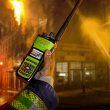Simple truths
The simple truth that every 911 official needs to understand is that people today increasingly expect to be able to send 911 texts to their local PSAP, because they can send texts to pretty much everyone else. And, when they discover that they are unable to send a text to 911, they have a tendency to get cranky.
Last year, a federal court ruled that the National Association of the Deaf and three members of the deaf/hearing-impaired/speech-impaired community could proceed with their lawsuit seeking to force the state of Arizona and various local jurisdictions in the state to implement text-to-911 service. The crux of the lawsuit is the claim that, without text-to-911 service, this community does not have equal access to the 911 system.
In Minnesota, the Minnesota State Academy for the Deaf in Faribault—about 50 miles south of the Twin Cities—has been very much engaged in watching our progress toward implementing text-to-911 service. We have made it a point to keep them in the loop, not only about our progress in implementing text-to-911 service across Minnesota but also about the challenges that impede the progress. We want to make sure that they understand we’re committed to providing this vital service but that it might take longer than they anticipate or want. We worked very closely with our colleagues in the Minnesota Department of Human Services—along with the Minnesota Commission of Deaf, DeafBlind and Hard of Hearing Minnesotans—to ensure that the messaging in our public-education campaign met the needs of those individuals they serve in the state.
Another simple truth is that implementing text-to-911 service on a statewide basis is the fastest and most efficient way to do the job. A statewide approach will result in a more consistent level of service across a much wider footprint, as all PSAPs in the state will be on the same page in terms of how to deploy the service, including technology choices, public-education campaigns and governance approaches. A statewide approach also closes the gap between the “haves” and “have nots”—otherwise, rural areas often lag behind their urban counterparts when implementing new technology, because they lack the financial resources. Finally, the costs of implementing text-to-911 service can be spread more equitably and evenly across every PSAP in the state, making such expenses easier to handle from a budgetary perspective for all involved in the effort.
From an operational perspective, there are several other reasons why a statewide approach is advantageous:
- Text-to-911 calls often cannot be transferred—It is easy to transfer a 911 voice call quickly, usually with the correct location data, because every PSAP can receive voice calls. But there is no way to transfer a text-to-911 call from one PSAP to another, if the receiving 911 center hasn’t implemented the requisite technology. In such circumstances, the PSAP that originally received the text has to place a voice call to the correct PSAP and then verbally relay the information contained in the text. This process eats up valuable time and creates the potential for errors that could delay emergency response, putting lives and property at greater risk.
- Emergencies often cross jurisdictional boundaries—In 2016, in the state of Texas, a woman was kidnapped. She managed to place a text-to-911 call while still captive in the vehicle. When she placed the call, she still was in a jurisdiction that had deployed text-to-911 service; however, within a few minutes, the vehicle had crossed over into an adjacent jurisdiction that had not deployed this life-saving technology. Fortunately, the receiving PSAP was able to share the contents of the text with the appropriate law-enforcement entities, which were able to locate her and avert a tragedy. But if the woman had waited just a few minutes to place the call—after she crossed the jurisdictional boundary—she would have received a message from the PSAP that it does not provide text-to-911 service. In that case, her only option would have been to place a 911 voice call and hope that the call-taker could pick up enough details from the background noise to locate her—truly a longshot. Speaking would have been out of the question because she could have been overheard by her captor, which would have placed her in even greater danger.
- People are forgetful—It is not unusual for people, especially in large metropolitan areas, to live in one municipality and/or county and work in another. If text-to-911 is available where they live, they might not remember—especially in the heat of the moment—that it doesn’t exist where they work, with potentially disastrous consequences. There are 87 counties in Minnesota—most of them rural—and people often are unaware when they have crossed from one county into another.
- Consistent training—It is a no-brainer that developing one training curriculum that can be utilized statewide is much better that leaving 87 counties to their own devices.










